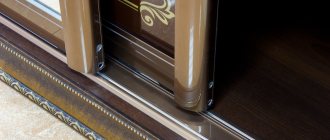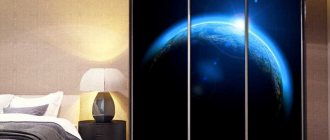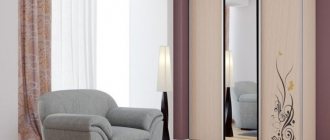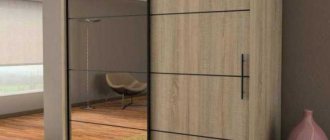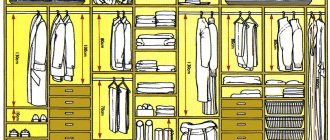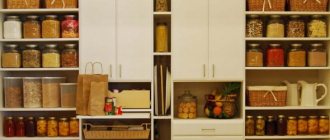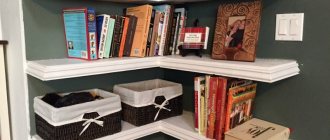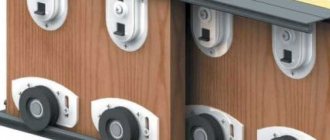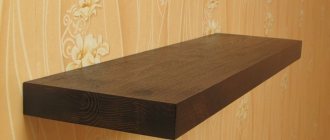Fastening shelves in a closet made of different materials
The majority of cabinets are made of laminated chipboard. A separate group includes models made of solid wood and MDF, as well as built-in cabinets with shelves made of plasterboard, furniture panels, plywood and other sheet materials.
In the future, we will start from the fact that both the body and the shelves of the cabinet are made of the same material - chipboard, MDF, plywood, solid wood with a thickness of 12-20 mm. Here we will consider the remaining, “non-standard” cases.
Fastening glass shelves
Fastening a glass shelf involves drilling the sides of the cabinet for shelf holders of various types. They can be “barrels” in a silicone shell, corners with a suction cup in the simplest version, or varieties of “pelicans” or “toucans” with a girth around the end of the shelf.
If the cabinet body itself is also made of glass, then UV gluing can be used for fastening. Also in the range of accessories for glass shelves you can choose special holders with through fastening. In this case, it is necessary to clarify the diameter of the holes for drilling (as a rule, fasteners are designed for installation in 5 or 8 mm holes).
Fastening mesh shelves
Mounting a metal mesh cabinet shelf is usually included in the kit. The shelf itself is sawn off to fit the internal size of the niche for installation; special holders are installed on the longitudinal rods on each side.
If a hanging rod or a support for inclined mounting is required (if it is a shelf for shoes), then the corresponding accessories are also purchased separately.
The metal shelf can be retractable. The draw-out mechanism is attached to the sides of the cabinet using regular 3x16 or 4x16 self-tapping screws. When installing, we recommend using the installation instructions - depending on the manufacturer, there may be nuances regarding the marking of reference points.
In some wardrobe systems, metal shelves are mounted on the wall, using special supporting rails and cantilever holders.
Built-in wardrobe: attaching shelves to walls
When installing built-in wardrobes, plastic corners of the “commander” type and consoles are usually used.
If the sides of the built-in wardrobe are made in the form of plasterboard partitions and it is not known where the mortgages are located, then it is better to use timber to support the shelves. A point connection will not be very reliable.
If necessary, attach heavy shelves or a mezzanine cabinet to loose walls. The beam will serve as a reliable support.
Original ideas for shelves
Often shelves play the role of a decorative element. Their job is to attract attention. To achieve this, contrasting shades, unusual materials and original shapes are used.
Small shelves, the design of which is dominated by corners, look quite interesting. Another original design idea is products made entirely of glass. Combinations of this material with metal and wood look incredibly impressive.
Shelves are also made from pipes, both metal and plastic. This is an ideal solution if you prefer modern design styles, such as loft and hi-tech.
There are many ideas for these furniture products. And every year designers delight us with something new. So you can easily choose the appropriate option.
Through fasteners (with drilling) for confirmations
Confirmats are the most common through fasteners for shelves. To install, you will need to drill a hole in the end of the shelf with a diameter of 5 mm and on the front side of the side of the cabinet with a drill with a diameter of 8 mm. It is better to use a special confirmation drill. Since a countersink is still required for the head, the screw itself is flush with the surface of the sidewall. Next, the cap is hidden with a special self-adhesive plug, matched to the color of the chipboard.
A nuance: depending on the thickness of the sidewalls, the length of the confirmat is selected. For standard chipboard and MDF thicknesses of 16-18 mm, a 5x50 euroscrew is used; for thicker board materials, a longer one is used, up to 70 mm.
- Among the advantages of attaching shelves to confirmations, it is worth highlighting the ease of assembly and the low cost of the fasteners themselves.
- The downside is the need to drill through. Not everyone likes the “holey” sides of the cabinet from an aesthetic point of view. Although the self-adhesive plugs are color-matched, they are still visible. Also furniture assembled through repeated assembly and disassembly.
Hidden fastening of shelves in the closet
If the side of the cabinet remains visible and you want to maintain the integrity of the coating, then you can use hidden, invisible fasteners to install shelves.
Furniture dowels
The most affordable, but no longer as popular as before, is a furniture dowel. It can be made of solid wood and plastic. For better grip, the side surfaces of the dowels are made ribbed.
Why do furniture makers dislike fastening to dowels? Fasteners of this type are quite specific and require gluing. This means that additional clamps (clamps) are needed to fix the position and glue. And, of course, allotted time for the glue to dry. All this slows down the build.
Eccentric coupler
More modern hidden fasteners for shelves and tabletops are an eccentric (minifix) and a conical tie. This type of fastening requires a certain skill for installation and therefore a novice master may get a little stuck. You will have to drill several holes of different diameters for the sleeve and the dowel itself. Moreover, all of them must be performed strictly in the center relative to each other; moving left/right/sideways is unacceptable.
There are many varieties of eccentric couplers, but the principle is always the same. There is a dowel with a head and a sleeve that clings to the head. The sleeve can be rotated (as on minifixes and conical couplers), inserted and snapped into place.
The advantages of the eccentric are obvious - the possibility of quick dismantling, the permissibility of repeated assembly and disassembly, and “invisibility”. Only the upper part of the sleeve is visible, which is located on the inside of the side of the cabinet and can also be hidden with a self-adhesive plug.
This type of hidden shelf fastening can also include rafix, which is a kind of symbiosis of an eccentric and a shelf holder with fixation.
Article about furniture
Author - designer of the company DEZALT Sukhanov Eduard
Sometimes potential clients ask a question: “I can’t decide on the internal contents of the cabinet, what kind of cabinet I need.” How many shelves, rods, drawers should I make?
You start helping, forming the person’s wishes.
You need to solve a few questions for yourself and then it will become easier.
1. How many clothes on hangers or hangers will you store in your closet?
2. How many shelves will you need and what will you store on them?
3. Do you need a large mezzanine shelf in your closet?
4. Do you need a utility unit to store your ironing board, stepladder or vacuum cleaner?
5. Do you need boxes and how many?
6. Need a trouser holder, tie holder, basket or mesh shelf?
These are the very first and most important points in designing the insides of a wardrobe.
Clothes on hangers and hangers.
Outerwear is stored in the closet on hangers. Their thickness varies from 5mm. up to 40mm. The hangers are usually wider, from 30mm. up to 60mm. Measure the hangers you plan to use in your closet. Feel free to add 20mm. to thickness and multiply by the number of things you plan to store. You will get the required length of the clothes rail.
Know that the length of the solid rod is desirable 1000mm. If the clothes are short in length, you can make a 1200mm barbell. but that's the maximum. If you make the barbell larger, it will bend under the weight of your clothes. The problem with deflection can be solved with the help of support in the form of the same rod.
The ideal section size with a bar is from 500mm. up to 900mm.
Required number of shelves.
The simplest thing is to go to your current closet and count the number of shelves you use. Of course, you need to consider how many clothes you will add to your closet. Count the number of jeans or T-shirts you store on one shelf. Estimate how many similar shelves you will need. Think, do you need a shelf for bed linen? Maybe you prefer to store your shoes in boxes? Count the number of boxes that will fit on one shelf. We recommend the minimum dimensions of one shelf: width 350mm, height 300mm. Of course, you can increase or decrease the size, just decide what will go in these cells and whether it will be convenient to take and put clothes.
Mezzanine shelf in the closet.
If you have large things, such as a collapsible Christmas tree, travel suitcases, large boxes with things, pillows, bulky blankets, etc. It is advisable to make a long shelf under the ceiling, it is also called a mezzanine. On such a shelf it is convenient to store bulky items of non-everyday use.
The height of the mezzanine shelf is usually 450mm. from the ceiling. Remember that the top track of the compartment doors and the backing under it is 56mm. from the entrance of the shelf. Item taller than 394mm. won't fit. So, if you need to guarantee a suitcase with a thickness of 420mm, make the distance from the shelf to the ceiling 500mm.
If you already have a suspended ceiling, you cannot create a large mezzanine shelf. We won’t go into technical details now, just take my word for it.
Place for an ironing board or stepladder in the closet.
If you already have an ironing board at home, measure its folded dimensions. The cell in the closet should be larger, therefore, add 100mm on top, and at least 50mm in width. We already have a very detailed article on this topic on our website, called “Dimensions of cells in a closet for an ironing board, drying rack, stepladder.”
Drawers in a wardrobe.
Decide what you will store in the drawers. Again, the easiest thing is to study the contents of your boxes today. Will you be increasing the amount of clothing in your new closet? What will you store in them?
For example, for one family member you need at least two drawers with a front height of 200mm, this is for underwear. If, for example, a husband and wife will use the closet, it is advisable to draw 4 pieces on the diagram. You can place them in different directions of the closet, even divide the entire closet in half. For example, the left side is your spouse, the right side is yours. They do this very often.
Drawers should not be made too low, near the floor. It’s better to make a shelf at the bottom with a height of 300-350mm, and then place the first drawer.
We do not recommend storing bedding in drawers; it will suffocate there.
If you like to store hats, scarves, gloves in drawers, you should increase its depth, make the front at least 300mm.
The width of the drawers may be limited due to compartment doors. We won’t go into these details now, draw the diagram as you want, we will adjust it later.
By the way, closers on drawers in wardrobes are not justified. There is no need to compare a sock drawer with a kitchen drawer. The dressing room can still be smoothly finished, but the closet has doors. Each time you will have to wait for the drawer to close smoothly in order to close the compartment door.
Mesh shelves, baskets and various pull-out trousers.
Mesh shelves are convenient for storing shoes. Thanks to their transparency, you can easily see the pair you need and take it from the shelf. There are several nuances that need to be taken into account. The heels of women's shoes fall through the bars of the shelf. Leather shoes deteriorate faster if stored for a long time without a box. The mesh shelves rattle when you touch them with the sole of your shoe.
Storage baskets in the closet are not entirely appropriate, but they are installed if desired. They are good in spacious dressing rooms, because you can quickly find what you need, since you can see what is in them. Well, the things in them are well ventilated, there is no musty smell. For example, woolen items, if left in a closed drawer for a long time, can smell unpleasant and old.
There are several types of trouser holders and tie holders, which can be installed in the closet if desired. But again, we remind you that they are good in spacious dressing rooms, when the issue of preserving space is not urgent. Look closely at how much emptiness there is around the retractable mechanisms. How much extra would you be able to place things if not for all these extension mechanisms.
And so, you have figured out a little about how much clothes you need to place in your new closet. Now try to draw shelves, rods, drawers on a piece of paper. There is no need to try to draw in proportion to the view from the side. Just draw a closet with a view of the front wall, from the front. You can use a checkered piece of paper to maintain approximate proportions.
Did you draw it?
Now go to the place where the cabinet with the measuring tape will stand. Looking at the drawing, plot the heights and widths of the cells at least in the air. Imagine the inner filling. Any doubts? Take a break, think again. Put the drawing aside for a day or two. Then return to it. You can consult with your family and show a sketch. Sometimes our loved ones can give us good advice.
You yourself will understand that the option that you drew, corrected and thought about for several days is the best.
All you have to do is send us the drawing, or call us to your home for help. We will make the necessary adjustments, discuss the nuances with you and draw a clear drawing in a computer program. All articles
Corners for fastening shelves in a closet
Furniture corners, like fastening shelves for a closet, are not able to add rigidity to the body. Therefore, the internal filling must be combined with other types of rigid fasteners.
Conventional galvanized corners can be used in furniture assembly. But you should still choose fasteners among furniture fittings; they look more aesthetically pleasing. You can use plastic corners or those made of metal, with a plastic lid that snaps on top.
For deep and open shelves, various cantilever options are offered as fasteners. The design and color can be chosen at your discretion.
DIY photo of shelves
DIY floor hanger: materials and tools for work. Extraordinary photo ideas for creating a hanger - a hanger in the form of a tree, hangers made from natural elements, a hanger in the form of a ladder- Kitchen chairs: review of the best new products and modern design
Do-it-yourself furniture restoration: restoration ideas, affordable design options and a master class on updating old furniture (120 photos and videos)
Read here - DIY candlestick. Masterpieces in the interior from scrap materials: candlesticks made from glasses, from a bottle, from wood, from a jar. TOP 100 photo ideas
Help the site, repost 
0
How to attach removable shelves in a closet
If it is required that the shelf be removed and adjusted in height, stops are used for fastening - shelf holders. They are installed in holes with a diameter of 5 mm. Please note that the hole required is not through, unlike fasteners on confirmations (the diameter of the drill is the same).
The shelf holder can be not only “barrel” in shape, but also a “spatula”. For shelves that are narrow in depth, in which the shelf holders are located quite close to each other, there is a reason to use special shelf holders with fixation. They will “protect” the shelf from accidental tipping.
As with furniture corners, removable shelves do not add additional rigidity to the cabinet. Therefore, in high and wide sections they are alternated with those mounted on confirmats or eccentrics. Or they add additional stiffening ribs along the rear wall of the cabinet.
These are the main ways to attach shelves in cabinets. They are also used in other furniture for various purposes.
